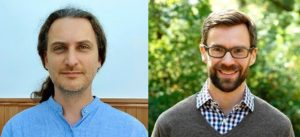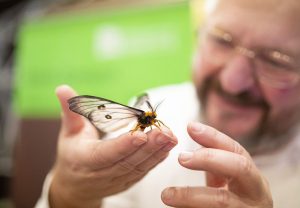
Professor Emmanouil Tranos is interested in the complexities that lie beneath our surface understanding of the so-called digital landscape – one that his research shows has an uneven terrain that can tell us more about urban trends than standard quantitative studies.
His previous work saw him develop and apply data modelling frameworks and computational workflows to expose the location-specific patterns of digital technologies, by looking at the digital traces left by economic activities and social behaviours. These spatial dimensions came into sharp focus during the COVID-19 pandemic when his research highlighted the importance of a social scientific approach to understanding the digital economy. Together with colleagues from Geographical Sciences and the University of Bristol’s Alan Turing Institute, Professor Tranos is embarking on an Enterprise Fellowship to explore how this data-driven approach could inform public and economic policies, as well as business and innovation.
Why is it important to understand the spatial dimensions of digital technology and the digital economy?
There’s a narrative that digital technologies are ubiquitous, that you can find them everywhere. The reality is that digital technologies and the digital economy are tied to location. There is a spatial dimension to digital – in short, geography matters.
To some extent, depending on your location, digital technology transcends space – two people can be in different places and spaces and still communicate, work together, interact in a meaningful and productive way. However, geography comes into play because, among other things, our ability to do that depends on the access that we have to technology and the availability of connectivity.
Identifying the digital traces left by economic activities is important because it allows us to observe patterns and changes in the way that can be useful for local authorities. It can also inform businesses, by revealing new specialisations and emerging areas of urban activity that innovation can focus on.
How did you get into this field and what motivated you to focus your research interests here?
My starting point was transport infrastructure. I was focusing on the various economical effects that transport infrastructures generate. I remember attending a class during my Master’s degree which made me realise the parallel between more traditional infrastructures and telecommunications, which also have infrastructural attributes. That made me curious about digital technologies.
There are multiple digital divides – I deliberately use the plural because there are different layers involved. There are factors relating to infrastructural access and connections, then there are our skills and capacities to use these digital tools, and lastly but maybe most importantly, we have to consider how the differences in our capacities to extract value out of these tools, depending on the jobs we do, for instance.
During the COVID-19 pandemic, the digital divides became very clear. There was a government mandate to work from home, but not everyone could do that. Large parts of the economy were not able to operate because they were not open to the digital model of working. That’s what we tried to capture by taking a detailed geographical look at the spatial dimensions that impose limitations on how digital technology applies.
You’ve developed some novel frameworks for understanding the dynamics of urban economic activities. What was your process?
There is one thing that everybody in this field of work agrees on – there is not any official data that we can consistently use or rely on. We have to be quite creative in capturing digital activities. For our previous study, in order to approximate the patterns of working from home, we had to use non-traditional data from a website that offers internet speed tests.
We also did a lot of work on large web archives, because they provided a great way to capture digital traces. We were able to map economic activities in Shoreditch in London, a well-known tech cluster, to see how those activities have evolved over time.
This allowed us to develop a method of identifying the geography and the evolution of specific types of economic activities at a much more granular level than official statistics in the UK, which are based on a system called Standard Industrial Classification (SIC), which hasn’t been updated since 2007 and would not have given us as much insight. If we had only relied on traditional data methods, many of the trends we spotted would have gone unnoticed.
By working in collaboration with the British Library, we were also able to look back at material from the mid-1990s and 2012, so from the early stages of the internet. The results we obtained were the equivalent to what some companies might have to spend months gathering, through qualitative research, interviewing people, focus groups, etc.
How does your Enterprise Fellowship build on your work to date?
For this project, we have further developed a framework of methods and data which can be applicable to other areas. This time, our focus is on developing a data set that is specific to Bristol. The information we are using now is much more current, in terms of the data sources and the web archives we can access.
Our plan is to be able to provide local authorities, specifically in cities, with data-based insights that can help them understand the types of economic activities that are within their localities and how their economies are evolving. As with the project in Shoreditch, and by working with complex data sets, I imagine we’ll be able to capture information about new previously unknown patterns and digital traces of economic activities.
What challenges lie ahead and how will you overcome them?
These data sets were not designed for people like me to conduct research. They are the side-product of digital technology. Trying to extract value from products that weren’t designed for these purposes is going to be challenging, but this is the only way to do what we want to do. We’re likely to be handling hundreds of terabytes of data every three months. We need to be able to sift through all of that data to find the interesting material.
This data has been available before but it hasn’t been utilised to this level of detail within social sciences, because of the complexities involved. We’re not only talking about large data sets but very unstructured data dumps of web archives that include the whole internet!
This kind of data is used by data analysts who offer consultancy services to cities and regions, but we are hoping to create an open access framework, to maintain the open science approach we have been working on already, for the benefit of local authorities.
What are you hoping to achieve? How is your work going to contribute to both social science and urban understanding?
Currently, there is no other way to consistently monitor economic activity. Our work offers an approach that fills that gap, without having to collect data in a costly and time-intensive manner. That information has the potential to help policymakers identify areas of interest where they need to focus their attention when developing industrial strategies and identifying interdependencies with other regions domestically and abroad through trade and supply-chain relationships.
At the Bristol level, we hope to be able to map the commercial and innovation profile of the locality, which could provide useful information for businesses. Part of our work will involve opening up a dialogue with local authorities, businesses and stakeholders about how we can make this information available in a commercial manner.
Emmanouil Tranos is Professor of Quantitative Human Geography at the University of Bristol and a Fellow at the Alan Turing Institute.



